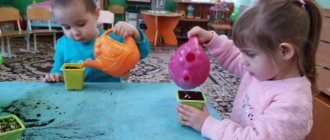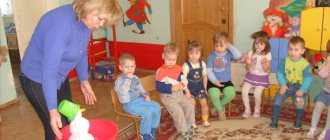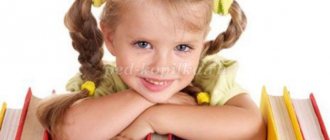Project for children of the younger group of preschool educational institutions “We are little wizards”
- October 28, 2015
Competition “My Pedagogical Initiative - 2015”
Nomination “Methodological work in preschool educational institutions”
Problem. It has been proven that the child best absorbs the knowledge that the child acquired in practical activities. Unfortunately, in preschool educational institutions, experimentation is used unreasonably rarely, especially in early preschool age. The importance of a child’s independent research activity is underestimated, despite its positive aspects, despite the active development of this area in preschool education.
Despite the fact that in experimental activities there are more opportunities for self-knowledge and self-determination of the child, for personal growth and the revelation of his individuality, teachers are reluctant to use this method in everyday activities, leaving it for open classes and mass entertainment events.
Relevance of the project. Preschoolers are natural explorers. And this is confirmed by their curiosity, constant desire to experiment, and desire to independently find a solution to a problem situation.
Experimentation gives children real ideas about various aspects of the object being studied, enriches the child’s memory, activates his thought processes, and includes an active search for solutions to problems.
Younger preschoolers, getting acquainted with the world around them, strive not only to look at an object, but also to touch it with their hands, tongue, smell it, and knock it. Children tear paper, take apart toys, play with sand, water and snow.
In everyday life, children often experiment with various substances themselves, trying to learn something new. They watch objects falling into the water (drowning or not drowning), testing icicles with their tongue in severe frost, etc. Exploratory behavior for a preschooler is the main source of gaining ideas about the world. We, adults, must actively help him in this.
The goal of the project: to develop cultural practices of showing the interest of children of primary preschool age in knowledge and research, to support the desire to demonstrate independence and initiative, and curiosity.
Tasks:
- Introduce children to some properties of water, air, light, paper.
- Develop your own learning experience.
- Support children's initiative, independence, and intelligence.
- Encourage friendly relationships during research activities.
- Form a cultural practice of showing interest and desire to expand your horizons.
Type of project: information and research, group.
Participants: teachers, children, parents.
Implementation timeframe : short-term (1 week).
Predicted result: development of the content of cultural practices to implement the project’s objectives:
- manifestation of sustainable cognitive interest in experimentation;
- developing the ability to consciously select objects and materials for independent activities;
- displaying initiative and creativity in solving assigned tasks;
- manifestation of mutual assistance, active social interaction;
- high-quality and interested participation of parents in the implementation of the project.
Main section of the program : social and communicative development.
Organization of activities within the project
Preparatory stage:
- problem formulation;
- determination of relevance, purpose and objectives;
- selection of methodological and fiction literature;
- selection of experiments for a given age;
- selection of equipment for conducting experiments.
Main stage:
- organization of subject-development environment,
- conducting experiments, experiments in a group and on a walk,
- individual work with children,
- independent experimental activities,
- outdoor games,
- reading fiction,
- conversations,
- productive activity of children.
The final stage:
1. Making a card index of experiments.
2. Exhibition of crafts made by parents and children.
Project technological map
Social and communicative development
| Cultural practices | |
| Kinds | Content |
| Integration of c.p.: – practice of game interaction, – knowledge of the world and self-knowledge, – communication practices | Games: “Find out who called?”, “It happens - it doesn’t happen.” D/exercise : “Find and bring a paper object.” Game exercises: “Turn a circle into a sun, an apple, a ball, a wheel, etc.” Problem situations:
Conversation – exercise “Taste and properties of food.” D/i “Catch up with your shadow” |
Cognitive development
| Cultural practices | |
| Kinds | Content |
| – Integration of c.p.: – knowledge of the world and self-knowledge, – free practice of children’s activities, – communication practices, – identification and interaction of the child with the surrounding society. | Experimental activities:
Experimentation games:
Experience game "Colored Ice"
Study:
|
Speech development
| Cultural practices | |
| Kinds | Content |
| Integration of c.p.: – communication practices, – knowledge of the world and self-knowledge | Conversations:
Reading:
Heuristic conversations:
|
Artistic and aesthetic development
| Cultural practices | |
| Kinds | Content |
| Integration of c.p.: – knowledge of the world and – self-knowledge, – free practice of children's activities | Shadow theater
Construction. Topic: “Dog kennel” (made of paper). Productive activity . “Polar bear” (from the palm of your hand). Modeling "Balloon". |
Physical development
| Cultural practices | |
| Kinds | Content |
| Integration of c.p.: – healthy lifestyle, – practice of game interaction | Finger gymnastics “Skillful Hands”, “Dog and Cat”. Outdoor games:
Gymnastics for the eyes “One drop, two drops...” Games with paper airplanes, plumes and pinwheels. Physical education lesson “Rainbow-arc”. Game m/n: “Cold-hot”. |
Interaction with parents
| Cultural practices | |
| Kinds | Content |
| Integration of c.p.: – knowledge of the world and self-knowledge, – communication practices | Introducing parents to the purpose of the project and types of joint activities for its successful implementation. Organizing joint activities with children at home:
Organizing a conversation with parents “What can’t and what should be done to maintain children’s interest in cognitive experimentation.” Involve parents in replenishing the experimentation center with new educational literature. |
Distribution of activities by activity centers
Center for theatrical activities: making characters for the shadow theater “The Tale of the Stupid Mouse.”
Center for experimental activities: preparation of all materials necessary for research activities (soap bubbles, various types of paper, paper boats, balloons, water containers, straws, screen for shadow theater).
Project implementation results (result):
The content of children’s cultural practices has expanded:
- a stable cognitive interest in experimentation appeared;
- increased ability to consciously select objects and materials for independent activities
- demonstrated initiative and creativity in solving assigned problems, and the ability for mutual assistance.
- Parents' interest in taking part in the implementation of the project has intensified.
- a recommendation was made for parents: “The role of the family in the development of the cognitive interests of a preschooler”
- a card file of experiments for practical activities has been compiled.
- An exhibition of paper crafts made by parents and children was organized.
List of literature:
1. A. Dietrich, G. Yurman “Why” 2. Van. Cleve J. “200 experiments” 3. Dybina O.V., et al. The unknown is nearby: entertaining experiences and experiments for preschoolers / O.V. Dybina (ed.). - M.: TC “Sfera”, 2001 4. L. L. Sikoruk “Physics for kids.” 5. Nikolaeva S.N. Methods of environmental education in kindergarten. M., 1999. 6. Nikolaeva S.N. Education of ecological culture in preschool childhood. M., 1995. 7. Perelman Ya.I. Entertaining tasks and experiments. Ekaterinburg, 1995. 8. “Design and organization of cultural practices in preschool childhood” / author M.V. Korepanova - Doctor of Pedagogical Sciences, Professor, Head of the Department of Pedagogy of Preschool Education, Dean of the Faculty of Preschool and Primary Education of Volgograd State Social Pedagogical University . 9. Ryzhova N.A. Ryzhova Sorceress - water. M., Linka-Press, 1997 10. Smirnov Yu.I. A book for talented children and caring parents. St. Petersburg, 1998 11. What is it? Who it? M., 1996.
Recommendations for parents
Author: Ovcharova Larisa Aleksandrovna, Master of Pedagogy, Private Secondary School “Rodnik”, Volgograd.
Montessori classes to develop a sense of order for children 2-3 years old
Such exercises help the child understand the principles by which our world exists; mainly here we work on sorting and classification.
Find a pair - Montessori classes for 2-3 years old
The principle of pair selection can be very widely used in working with children:
- Invite your child to sort his own socks and gloves.
- Print out images of animals and offer to compare the picture with existing toy models (the same can be done with your favorite cars, flowers, building models, etc.)
- Offer to find paired cards (colors, images, textures),
- Use special Montessori materials for 2 years and older
Sorting – complicated Montessori games for children from 2 years old
When the baby has mastered pairs, you can move on to a more complex option - sorting.
- Sort cards of different shades by color (you can cut pictures from magazines, scraps, colored cardboard, or you can buy a ready-made Montessori set),
- Remember Cinderella and offer to sort out different types of cereals. First, it is better to take larger grains: beans, chickpeas. Children's breakfast cereals with their cereals, pillows and rings can also be convenient,
- Sort out the box with grandma's buttons by shape, color or number of holes (you definitely have one!)
- Ask your child to put the cutlery in its place,
- Offer to clean up the kitchen and put all the cylinders and balls in one direction, and the cubes and parallelepipeds in the other,
- Rewind the salad: cucumbers to cucumbers, tomatoes to tomatoes, and so on
Establishing Montessori Sequences for a Child 3 Years and Under
- Lay out cards with simple stories and ask your child to remember the correct sequence of events.
- Use Montessori cylinders to help your child master the concepts of less-more and lower-higher,
- Learn simple self-care steps, breaking them down into steps. This way you can learn how to brush your teeth, take a shower, care for animals, and get ready for kindergarten.



